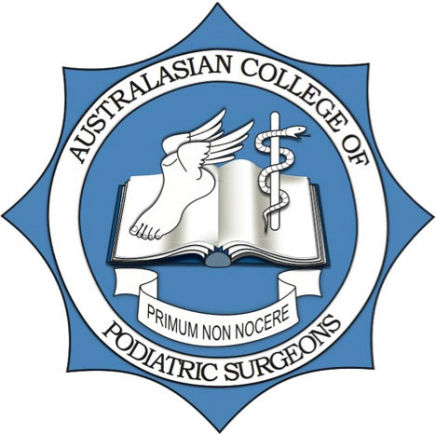Why Podiatric Surgery? – Part One
- September 8, 2018
-
Clayton Clews
- Recent Articles, Uncategorized

Why Consult with a Podiatric Surgeon?
Many conditions of the foot and lower limb do not respond to non-surgical methods of care. This is when the option of surgery has to be seriously considered.
Podiatric surgeons are specialist podiatrists, who have undergone extensive training in podiatric medicine, surgery, general medicine and its relevant specialist fields and in pharmacology. Podiatric surgeons are extremely well trained to surgically treat disorders of the foot, ankle and lower limb. A copy of the ACPS (Australasian College of Podiatric Surgeons) training program, which outlines the objectives, criteria and requirements to complete fellowship, can be found here.
Podiatric Surgeons in Australia are approved by the Australian Health Professions Regulatory Authority (AHPRA) and are considered as specialists, analogous with specialists within the fields of dentistry and medicine. Podiatric surgeons in Australia currently operate within the private hospital system. With time, it is hoped the specialty will become integrated within the public health sector, similar to what has happened in the United Kingdom. Podiatric surgeons in the United States operate within the private sector, a structure which is equivalent in many ways to the Australian public health care model of care.
Integration of podiatric surgery in the Australian public system will be of great benefit to the community, as foot and ankle complaints are common and can be debilitating, sometimes life threatening. The need for a satisfactory level of foot and ankle health, is critical for every Australian to lead a full and productive life. It is hoped the full integration of this specialty into the Australian health care model will occur, without too much further delay. The Australian College of Podiatric Surgeons (ACPS) has been working closely with the Australian Health Department for a number of years now, to secure Medicare rebates for surgical services provided by podiatric surgeons and for anaesthetic costs associated with those services. The ACPS is optimistic, as the evidence demonstrates both the safety and cost effectiveness of Australian podiatric surgeons and of course, the demand for such services is obvious, in an aging and growing Australian population.
Characteristics of Podiatric Surgery
Podiatric surgeons are able to treat conditions affecting the foot and ankle. These conditions include bunions, osteoarthritis (of all joints of the foot and the ankle), hammer/claw toes, nerve entrapments, soft tissue masses, in-growing toenails, ganglions, tendinopathies, flat feet and high arch feet. Other disorders such as recalcitrant triceps surae inflexibility and joints affected by gout/inflammatory arthritis can also be treated. Podiatric surgeons are trained to manage the diabetic foot and can play a major role in reconstructive surgery associated with the diabetic foot, including prophylactic (preventative) foot surgery. If you require a podiatrist in Canberra ACT, then contact us at ACT Podiatry today.
Podiatric surgery is the only surgical specialty fully dedicated to the non-surgical and surgical management of disorders of the foot, ankle and related structures. As its focus is on the foot and ankle, specialists within the field are well trained in performing surgery on small, tight and closely packed joints. Podiatric surgeons use the principles of plastic surgery combined with orthopaedic surgery and as such, gentle tissue handling and precise dissection are very important techniques, which are mastered.
An understanding of general medicine and an ability to take a detailed medical history are also characteristics of training emphasised in podiatric surgery. Medical rotations in plastic surgery, anaesthetics, pathology, medical imaging, rheumatology, vascular surgery, orthopaedics and the ‘high risk’ foot are commonly undertaken to complete the training program.
Podiatric surgeons are highly trained in the area of ‘differential diagnosis’, often using medical imaging strategically, to augment clinical findings. Pain and disability associated with the foot has many origins. It is important to be able to differentiate these. For example, pain and disability can be caused by abnormal foot biomechanics, infection, systemic disease (ie- inflammatory joint conditions, gout, diabetes), trauma, overuse (as in sports injuries), hereditary factors and even congenital (birth) disorders. Nerve injury at the level of the back can cause neuropathic foot pain… and the list continues.
Podiatric surgeons are able to marry the nonsurgical forms of treatment with the surgical and are well trained in post-operative management. It is one thing to do the surgery, but after care and long term follow-up are critical to achieve an optimum result for the patient.
Podiatric surgeons are well trained to recognise and manage potential complications, should and when they occur. They work closely with anaesthetists and a surgical team to achieve the best in patient care. Referral to the general medical practitioner or certain specialists, is sometimes is necessary for the best in patient outcomes, including for the management of complications.
To complete a ‘fellowship program’, podiatric surgeons in Australia have had to publish research, complete overseas rotations (to obtain exposure to international health care models) and sit both practical and oral examinations.
In concluding, it is readily apparent that podiatric surgeons are highly trained and skilled in treating disorders of the foot and ankle… and their associated structures.
Suite 8 (Ground Floor), 146 Scollay St, Greenway ACT 2900
6287 4889
6293 2325
[email protected]
ACT Podiatry : Advanced Foot & Ankle Centre
Canberra Podiatric Surgeon
Suites 16-17 (First floor) 14-16 Brierly St, Weston ACT 2611
6287 2818
6293 2325
[email protected]
ACT Podiatry : Advanced Foot & Ankle Centre
Canberra Podiatric Surgeon
Copyright © 2018, ACT PODIATRY | SEO by High Jump Digital

